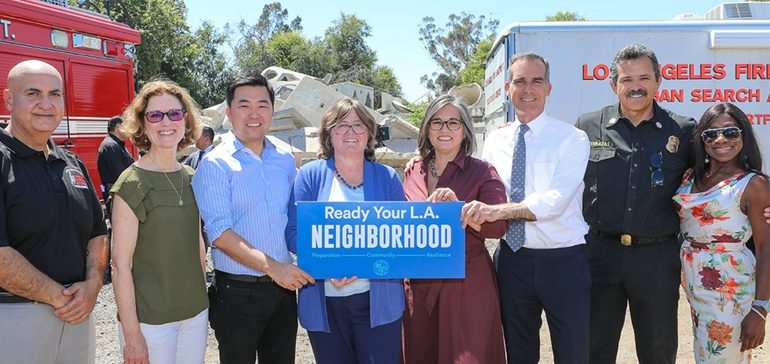LA seeks neighborhood buy-in to boost earthquake preparedness

By Kira Barrett
Dive Brief:
- Los Angeles Mayor Eric Garcetti announced a re-emphasis on the city’s earthquake preparedness measures called “Ready Your LA Neighborhood” (RYLAN), according to a press release. The initiative builds on the current strategy of training citizens to develop community action plans, but this time specifically addresses neighborhood councils to mobilize residents.
- Garcetti encourages all neighborhood councils to schedule an initial community meeting, and the emergency management department (EMD) will provide RYLAN training materials and invitations. Councils are encouraged to create a contact list and action plan to determine which neighbors will require assistance in the “critical first hour” after a disaster. Garcetti also called on every neighborhood council to host a block party to raise interest.
- Meanwhile, the city is currently tweaking the ShakeAlertLA app to lower the earthquake warning threshold to a Magnitude 4.5, which will roll out at the end of July.
Dive Insight:
The initiative, detailed in a brochure on the RYLAN website, covers four aspects: search and aid; care and sheltering; communications; and utility and safety. Action items for residents include taking care of children who may be home alone, monitoring FM/AM radio stations, shutting off leaking natural gas and conducting a door-to-door safety check.
“In L.A., we are kind of known for not knowing who our neighbors are, it’s sort of a terrible reputation and actually it’s true,” Robert de Groot, ShakeAlert national coordinator for communication, education, and outreach, told Smart Cities Dive.
However, Garcetti’s RYLAN initiative is nothing new, according to David Eisenman, director of the UCLA Center for Public Health and Disasters. The press release describes a strategy that’s been in place since 2018, and engaging the neighborhood council is just a new part of the tried-and-true “Map Your Neighborhood” (MYN) that many cities use, with an “L.A. twist.”
While MYN can be valuable and is widely accepted, it only reaches a very small group of people, said Eisenman.
“It tends to collect people who are already engaged in improving their neighborhood, people who are willing to go to meetings,” he said. “There are whole parts of communities that are not getting involved and are cut off. It’s really important to reach out to those groups of people and get them in.”
Research shows that a majority of people don’t participate in community-led disaster-preparedness efforts; in one study conducted in California, respondents had a 16% community engagement score when working with neighbors to prepare for disasters.
Aside from the RYLAN efforts, the ShakeAlertLA app is also designed to keep neighborhoods safe. However, L.A. residents recently criticized ShakeAlertLA because it was programed to only alert residents for earthquakes that were “potentially damaging,” and did not sound off during the two recent earthquakes that occurred on July 4 and 5.
De Groot said that in the new version of the app, the alert will have a different message.
“They’ve actually lowered that threshold from ‘potentially damaging’ shaking to it being felt,” said de Groot. “As we change thresholds we have to be really clear, and really let [residents] know what they have to expect.”
More alerts, even if they’re unnecessary, could actually be more beneficial, according to Eisenman.
“People are quite patient with false alarms and understand the concept. It lets them know they can trust that an alert will come,” he said.
You can view the full Smart Cities Dive article here.